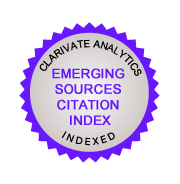Evaluation of the Morphology and Malachite Green Absorption Capacity of Modified Electrospun Chitosan Nanofibers
Hien Thi Thanh Nguyen(1*), Thao Thi Ngoc Dang(2), Tan Minh Ha(3), Nhi Tran Yen Nguyen(4)
(1) Faculty of Chemical Engineering, Ho Chi Minh City University of Industry and Trade, 140 Le Trong Tan Street, Tan Phu District, Ho Chi Minh City 700000, Vietnam
(2) Faculty of Chemical Engineering, Ho Chi Minh City University of Industry and Trade, 140 Le Trong Tan Street, Tan Phu District, Ho Chi Minh City 700000, Vietnam
(3) Faculty of Chemical Engineering, Ho Chi Minh City University of Industry and Trade, 140 Le Trong Tan Street, Tan Phu District, Ho Chi Minh City 700000, Vietnam
(4) Faculty of Chemical Engineering, Ho Chi Minh City University of Industry and Trade, 140 Le Trong Tan Street, Tan Phu District, Ho Chi Minh City 700000, Vietnam
(*) Corresponding Author
Abstract
Keywords
Full Text:
Full Text PDFReferences
[1] Nasrollahzadeh, M., Sajadi, S.M., Sajjadi, M., and Issaabadi, Z., 2019, “Applications of Nanotechnology in Daily Life” in Interface Science and Technology, Academic Press Cambridge, MA, US, 113–143.
[2] Findik, F., 2021, Nanomaterials and their applications, Period. Eng. Nat. Sci., 9 (3), 62–75.
[3] Islam, M.S., Ang, B.C., Andriyana, A., and Afifi, A.M., 2019, A review on fabrication of nanofibers via electrospinning and their applications, SN Appl. Sci., 1 (10), 1248.
[4] Ali, S.H., Mahammed, M.A., and Yasin, S.A., 2024, Characterization of electrospinning chitosan nanofibers used for wound dressing, Polymers, 16 (14), 1984.
[5] Xue, J., Wu, T., Dai, Y., and Xia, Y., 2019, Electrospinning and electrospun nanofibers: Methods, materials, and applications, Chem. Rev., 119 (8), 5298–5415.
[6] Geng, X., Kwon, O.H., and Jang, J., 2005, Electrospinning of chitosan dissolved in concentrated acetic acid solution, Biomaterials, 26 (27), 5427–5432.
[7] Salas, C., Thompson, Z., and Bhattarai, N., 2017, “Electrospun Chitosan Fibers” in Electrospun Nanofibers, Woodhead Publishing, Cambridge, MA, US, 371–398.
[8] Cheba, B.A., 2020, Chitosan: Properties, modifications and food nanobiotechnology, Procedia Manuf., 46, 652–658.
[9] Xu, J., Zhang, J., Gao, W., Liang, H., Wang, H., and Li, J., 2009, Preparation of chitosan/PLA blend micro/nanofibers by electrospinning, Mater. Lett., 63 (8), 658–660.
[10] Cheng, Y., Farasati Far, B., Jahanbakhshi, M., Bahrami, S., Tamimi, P., Sedaghat, M., and Ghazizadeha, E., 2023, Exploring the potential of a polyvinyl alcohol/chitosan-based nanofibrous matrix for erythromycin delivery: Fabrication, in vitro and in vivo evaluation, RSC Adv., 13 (27), 18450–18460.
[11] Choo, K., Ching, Y.C., Chuah, C.H., Julai, S., and Liou, N.S., 2016, Preparation and characterization of polyvinyl alcohol-chitosan composite films reinforced with cellulose nanofiber, Materials, 9 (8), 644.
[12] Lou, T., Yan, X., and Wang, X., 2019, Chitosan coated polyacrylonitrile nanofibrous mat for dye adsorption, Int. J. Biol. Macromol., 135, 919–925.
[13] Sakib, M.N., Mallik, A.K., and Rahman, M.M., 2021, Update on chitosan-based electrospun nanofibers for wastewater treatment: A review, Carbohydr. Polym. Technol. Appl., 2, 100064.
[14] Phan, D.N., Lee, H., Huang, B., Mukai, Y., and Kim, I.S., 2019, Fabrication of electrospun chitosan/cellulose nanofibers having adsorption property with enhanced mechanical property, Cellulose, 26 (3), 1781–1793.
[15] Sasmazel, H.T., and Ozkan, O., 2013, Advances in electrospinning of nanofibers and their biomedical applications, Curr. Tissue Eng., 2 (2), 91–108.
[16] Younes, K., Mouhtady, O., Chaouk, H., Obeid, E., Roufayel, R., Moghrabi, A., and Murshid, N., 2021, The application of principal component analysis (PCA) for the optimization of the conditions of fabrication of electrospun nanofibrous membrane for desalination and ion removal, Membranes, 11 (12), 979.
[17] Chen, Z.Y., He, B., Bian, Y., Zhang, Y., and Feng, X., 2024, Malachite green and related substances in environmental samples: Updates on pretreatment and analysis methods, J. Environ. Chem. Eng., 12 (5), 113812.
[18] Abubakar, H.L., Tijani, J.O., Abdulkareem, A.S., Egbosiuba, T.C., Abdullahi, M., Mustapha, S., and Ajiboye, E.A., 2023, Effective removal of malachite green from local dyeing wastewater using zinc-tungstate based materials, Heliyon, 9 (9), e19167.
[19] Oladoye, P.O., Ajiboye, T.O., Wanyonyi, W.C., Omotola, E.O., and Oladipo, M.E., 2023, Insights into remediation technology for malachite green wastewater treatment, Water Sci. Eng., 16 (3), 261–270.
[20] Gavrilenko, N.A., Volgina, T.N., Pugachev, E.V., and Gavrilenko, M.A., 2019, Visual determination of malachite green in sea fish samples, Food Chem., 274, 242–245.
[21] Kamath Miyar, H., Pai, A., and Goveas, L.C., 2021, Adsorption of malachite green by extracellular polymeric substance of Lysinibacillus sp. SS1: Kinetics and isotherms, Heliyon, 7 (6), e07169.
[22] Naser, J.A., Al-ani, F.A.A., Radhi, I.M., and Himdan, T.A., 2020, Kinetic study of adsorption of malachite green dye on poly aniline-formaldehyde/chitosan composite, IOP Conf. Ser.: Mater. Sci. Eng., 928 (5), 052005.
[23] Abou-Gamra, Z.M., and Ahmed, M.A., 2015, TiO2 nanoparticles for removal of malachite green dye from waste water, Adv. Chem. Eng. Sci., 5 (3), 373–388.
[24] Nguyen, H.T.T., Tran, T.N., Ha, A.C., and Huynh, P.D., 2022, Impact of deacetylation degree on properties of chitosan for formation of electrosprayed nanoparticles, J Nanotechnol, 2022 (1), 2288892.
[25] Jampafuang, Y., Tongta, A., and Waiprib, Y., 2019, Impact of crystalline structural differences between α-and β-chitosan on their nanoparticle formation via ionic gelation and superoxide radical scavenging activities, Polymers, 11 (12), 2010.
[26] Chinnappan, B.A., Krishnaswamy, M., Xu, H., and Hoque, M.E., 2022, Electrospinning of biomedical nanofibers/nanomembranes: Effects of process parameters, Polymers, 14 (18), 3719.
Article Metrics
Copyright (c) 2025 Indonesian Journal of Chemistry

This work is licensed under a Creative Commons Attribution-NonCommercial-NoDerivatives 4.0 International License.
Indonesian Journal of Chemistry (ISSN 1411-9420 /e-ISSN 2460-1578) - Chemistry Department, Universitas Gadjah Mada, Indonesia.













